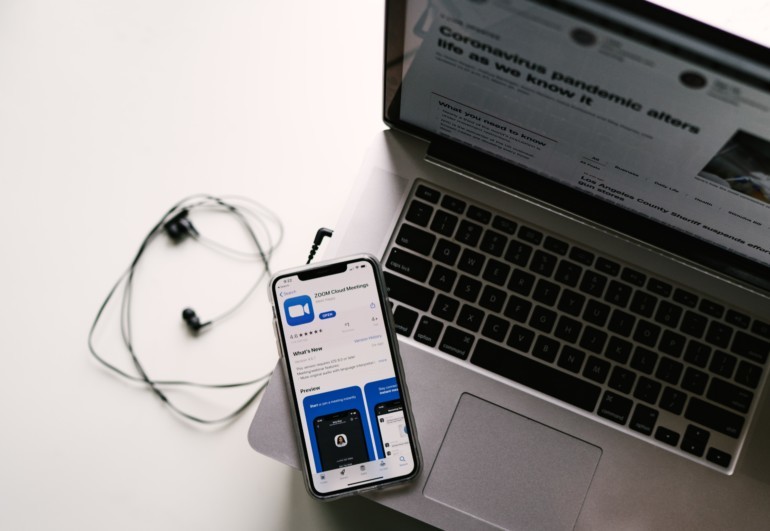The COVID-19 pandemic obviously forces most everyone not just to think—but also to convene—outside of the box or inside a laptop or phone.
According to the Business of Apps, in March, “Zoom was seeing 200 million daily meeting participants. This compares to 10 million in December 2019.”
Innovative leadership is increasing technology’s capacity for creative and social connection driven by the innate understanding and belief that social connection is both valuable enough to protect, and necessary for survival.
Yes, everyone can still experience work, hobbies, birthdays, holidays, game and movie nights, sports, exercise, community and philanthropy, and even dating while social distancing without completely losing the quality or elements of those experiences.
Even Saturday Night Live has gone virtual in two recent Stay-At-Home editions.
I’ve struggled with my own self-doubts on the preservation of the effectiveness and quality of utilizing these new online spaces. But I recently experienced firsthand a virtual effort to maintain momentum in an eight-hour virtual Zoom convening with 20 other social justice leaders plus staff in different cities through The OpEd Project. The experience added a layer of understanding innovative leadership that is emerging in many sectors, but vastly underutilized across other disciplines.
While unemployment has hit record highs, with 26.5 million Americans filing for unemployment since mid-March this year, with many having lost their non-essential jobs, some niches of the job market have adapted to the demands of quarantining through online adaptations.
New job trends have forged pathways in opportunities to fulfill the innovation necessary to support—or at least contribute to– the global economy. Data from LinkedIn highlights that growth and demands are high in sectors that meet the increasing novel urgency this pandemic has created.
Healthcare workers are more in demand to help with capacity issues. Online companies like Amazon are hiring to cover the increased demand from people using it’s platform to avoid shopping in public. Some big tech companies and startups continue to hire to keep up with the increasing demands for teleconferencing platforms and online tech products to keep us connected.
As demand for services have risen, increased opportunities in the gig economy are highlighting its growing importance and the importance of protecting its workforce. According to one report, a mobile delivery platform saw a 78% increase in job postings for couriers in one month.
With school closures from K-12 as well as the university level and beyond, much of education has shifted online for the foreseeable future; leaving many teachers scrambling to utilize or even create curriculum that would keep their students engaged for the school year.

Alejandra Ramos Gomez, an elementary school teacher in Dallas, related to the challenges teachers are facing in maintaining student engagement. She says in addition to providing emotional support, she hosted an online talent show for her students.
Her creativity in connecting people in an online community is evidenced by how many people joined her online dance class in one week. In an effort to share her joy during these bleak times, Gomez’s Latin dance class saw an increase of 400 members. You can’t fit that many people, or the power they bring to the dance floor, in a brick and mortar gym class.
During weekly virtual staffing meetings, my colleagues and I, who work in social services now virtually serving multicultural populations, explore and share self-care ideas to help mitigate compassion fatigue in social services, no doubt, exacerbated during these times.
Our director suggested the app called HouseParty, and recommended it as a fun way to stay connected with friends. HouseParty reported a record of 50 million sign- ups in the past month alone. I hopped on recently for a scheduled game night with a dear friend, a token of joy during challenging times.
Certainly, the innovation paving this new way of “connecting” doesn’t change or replace the innate need for real life human connection or core human values. It’s possible that after this pandemic, these human values will have shaped and impacted the considerations corporations and systems make for their workers and consumers.
While some bemoan technology’s encroachment in our lives, it can be used for good. As we collectively navigate virtual connectedness during these times, I’m grateful to have the world at our fingertips.
And yes, this unprecedented innovation also highlights a great technology divide leaving underserved and under-connected populations without access to these spaces. A 2018 study by the Pew Research Center found that 20% of high-school students are not able to complete their homework due to lack of internet access.
Now more than ever, people need the access and opportunity to connect. In unprecedented times like now, connection that is both safe and fulfilling is necessary to sustain human need. Preparing for life post-COVID relies on us not missing out on those experiences.
Creative, bold and thoughtful innovation based on human values and needs can offer ways to utilize technology for the connections everyone needs.
Sonja Marjanovic, senior research leader and head of THIS Institute at Rand Corporation- Europe recently wrote, “When there is a critical mass of will and clear priorities, innovation can quickly reach the front line.”
I experienced this firsthand, in a virtual space sustaining ideas, making space to tell our stories, and writing the history we are living. It’s connection everyone needs now.
More from Better:
Mental Health Check: “How Are You?” Becomes a Loaded Question
The Power of Pretend: Chicago Mom’s Free Children’s Book Takes Kids On An Adventure at Home
Love and Longing During COVID-19: Coping With the Emotional Toll of Social Distancing
 Aceil Rashid is a Dallas native and alumna of University of Texas at Dallas where she graduated with a dual Bachelors of Arts in Biology and Psychology. From a court liaison to a client advocate and now the Transitional Housing Director at Mosaic Family Services, Aceil has worked alongside families and survivors of trauma in their efforts to heal and recover into a place to call home. In addition to her work, she dedicates her time to outreach, educating professionals and communities about gender based social justice and cultural humility. Aceil is currently a fellow with the Public Voices Op-ed Project. While she is not known to have a superpower if she did it would be teleportation and the ability to be in two places at once. For everything else she wears a cape.
Aceil Rashid is a Dallas native and alumna of University of Texas at Dallas where she graduated with a dual Bachelors of Arts in Biology and Psychology. From a court liaison to a client advocate and now the Transitional Housing Director at Mosaic Family Services, Aceil has worked alongside families and survivors of trauma in their efforts to heal and recover into a place to call home. In addition to her work, she dedicates her time to outreach, educating professionals and communities about gender based social justice and cultural humility. Aceil is currently a fellow with the Public Voices Op-ed Project. While she is not known to have a superpower if she did it would be teleportation and the ability to be in two places at once. For everything else she wears a cape.

